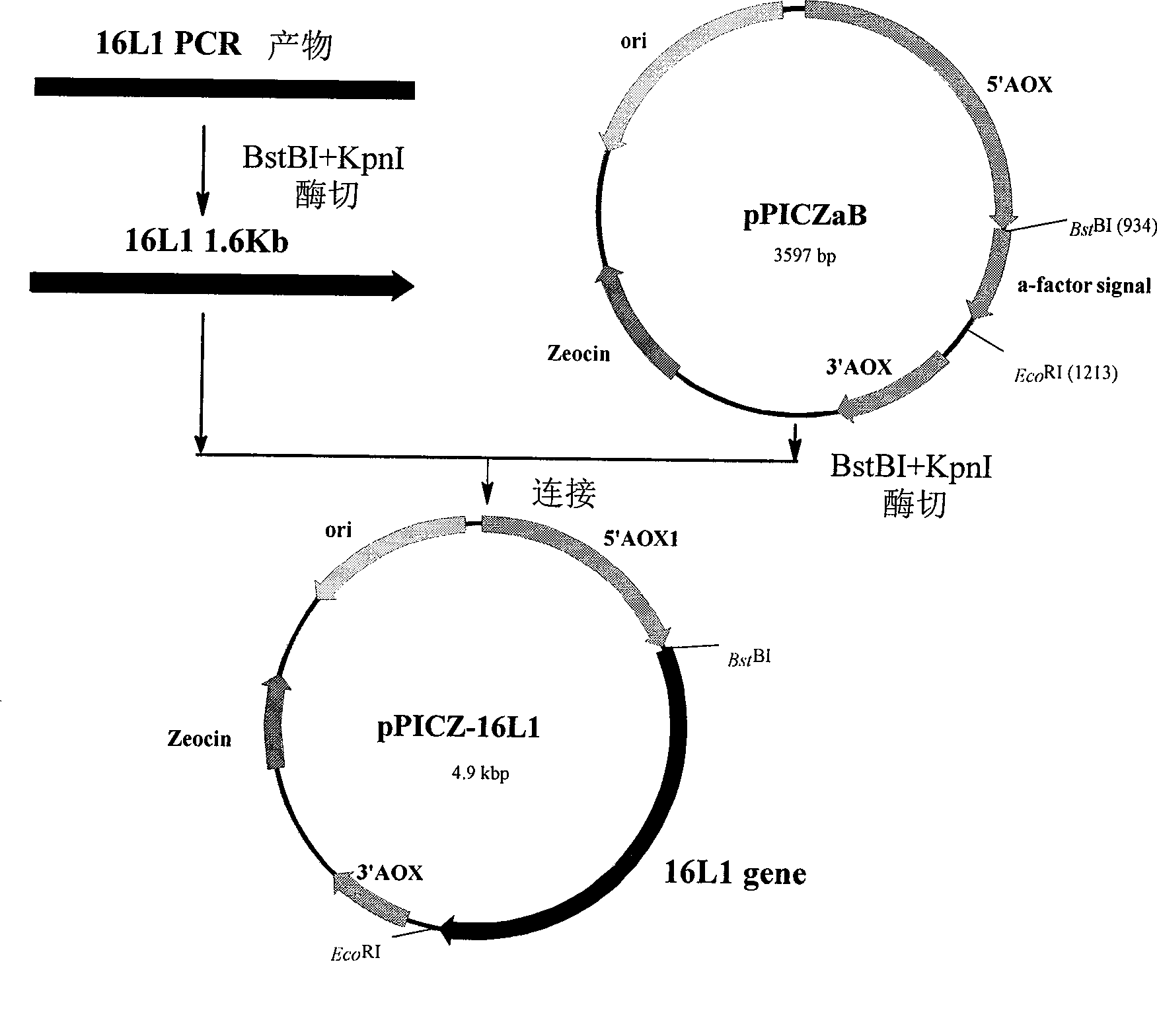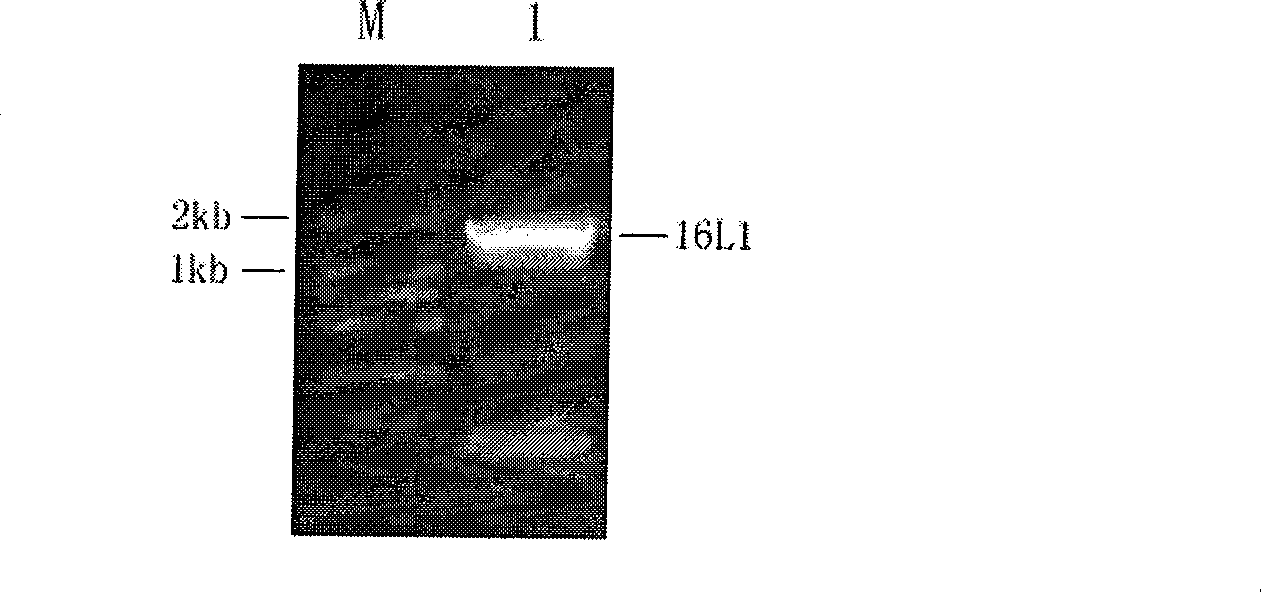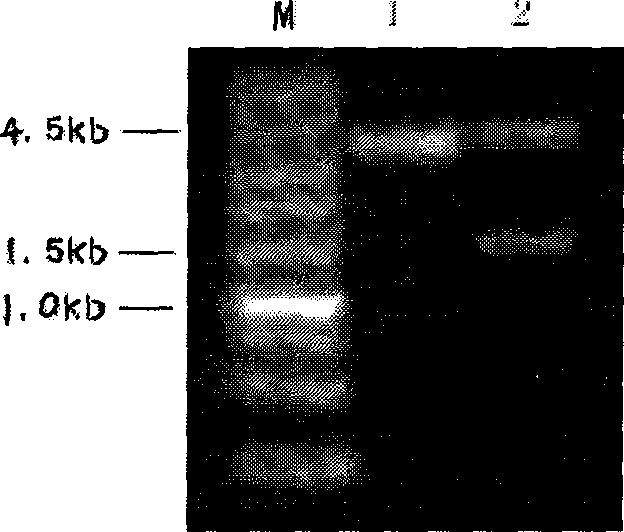16 type human papilloma virus major capsid protein L1 gene
A technology of papilloma virus and its main capsid protein, which is applied in the field of bioengineering to achieve the effects of low cost, high yield, and uniform and stable product properties
- Summary
- Abstract
- Description
- Claims
- Application Information
AI Technical Summary
Problems solved by technology
Method used
Image
Examples
Embodiment 1
[0032] Example 1 , Design and synthesis of codon-optimized L1 gene of HPV16
[0033] 1.1. Design of codon-optimized L1 gene of HPV16
[0034] The present invention relates to a DNA molecule encoding the main capsid protein L1 of human papillomavirus type 16 (HPV16) optimized by the preferred codon of Pichia pastoris. The three segments are obtained by optimizing the codon and correcting the frequency of the optimal codon. DNA sequence, its sequence is shown in SEQ ID NO: 1, 2 and 3 respectively, specifically as follows:
[0035] Firstly, the natural HPV16L1 gene is modified, and all amino acids of it are codons with the highest frequency of use, and a brand-new HPV DNA sequence, namely SEQ ID NO:1, is designed.
[0036] Then, in order to avoid the GC ratio of the translated mRNA being too high, the influence of the secondary structure of the mRNA on the translation efficiency, and to avoid some commonly used enzyme cutting sites, some corrections are made to the optimal cod...
Embodiment 2
[0052] Example 2 , Expression vector construction of HPV 16L1 gene
[0053] Cloning the optimized sequence of SEQ ID NO: 1 into the expression vector of Pichia pastoris, the construction method is as follows figure 1 As shown, the specific steps are as follows:
[0054] 2.1. Synthesize the forward primer and reverse primer required to amplify HPV 16L1, the sequence is as follows:
[0055] Forward primer: 5'-ACTAATTA TTCGAA ACGATGTCTTTTGTGG-3';
[0056] Reverse primer: 5'-AGC GGTACC CTATTACAACTTTTCTCTTTCTTTC-3'.
[0057] Wherein, the forward primer includes a BstBI restriction endonuclease site; the reverse primer includes a KpnI restriction endonuclease site positioned at the flank of the stop codon, and the enzyme cutting sites are respectively shown in the underline in the primer sequence .
[0058] 2.2. Using the above primer pair as primers, and using the pUC-16L1 obtained in Example 1 as a template, PCR amplification was performed, and the amplified product was ...
Embodiment 3
[0060] Example 3 , Construction and expression of HPV 16L1 Pichia pastoris expression strain
[0061] 3.1. Construction of HPV 16L1 Pichia pastoris expression strain
[0062] The pPICZ-16L1 plasmid was single-digested with Sac I restriction endonuclease to make it linearized, and the empty plasmid pPICZaB was subjected to the same digestion as a negative control.
[0063] Add absolute ethanol to the enzyme digestion reaction solution to obtain DNA precipitation, dissolve the linearized pPICZ-16L1 fragment with a small amount of double distilled water, and transform Pichia pastoris X-33 (Invitrogen) by electroporation. The electroporation conditions are:
[0064] The DNA fragment is 5 micrograms, the voltage is 1500 volts, the resistance is 25 ohms, and the electric shock time is 5 milliseconds.
[0065] The electroporation products were plated on YPDS agar containing 200 μg / ml Zeocin. Since the pPICZaB vector carried the Zeocin resistance gene, the transformation products c...
PUM
 Login to View More
Login to View More Abstract
Description
Claims
Application Information
 Login to View More
Login to View More - R&D
- Intellectual Property
- Life Sciences
- Materials
- Tech Scout
- Unparalleled Data Quality
- Higher Quality Content
- 60% Fewer Hallucinations
Browse by: Latest US Patents, China's latest patents, Technical Efficacy Thesaurus, Application Domain, Technology Topic, Popular Technical Reports.
© 2025 PatSnap. All rights reserved.Legal|Privacy policy|Modern Slavery Act Transparency Statement|Sitemap|About US| Contact US: help@patsnap.com



